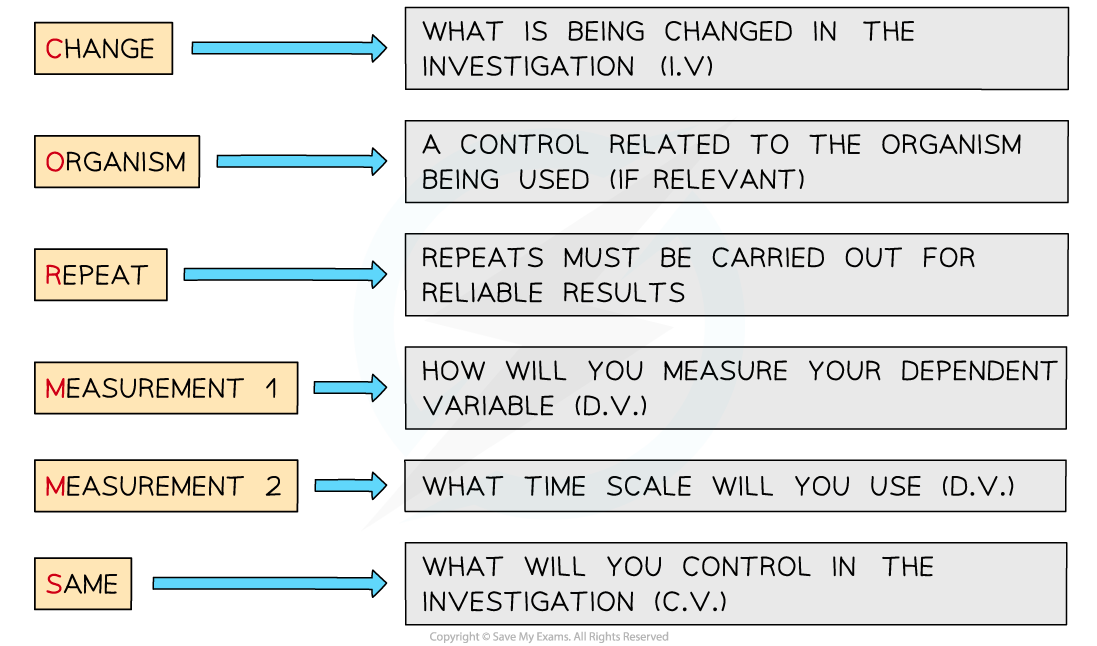Practical: Food Tests (Edexcel GCSE Biology)
Revision Note

Author
RuthExpertise
Biology
Practical: Food Tests
Preparing a sample
- Before you can carry out any of the food tests described below, you may need to prepare a food sample first (especially for solid foods to be tested)
- To do this:
- Break up the food using a pestle and mortar
- Transfer to a test tube and add distilled water
- Mix the food with the water by stirring with a glass rod
- Filter the mixture using a funnel and filter paper, collecting the solution
- Proceed with the food tests
Test for glucose (a reducing sugar)
- Add Benedict's solution to the sample solution in a test tube
- Heat in a boiling water bath for 5 minutes
- Take the test tube out of the water bath and observe the colour
- A positive test will show a colour change from blue to orange / brick red

The Benedict's test for glucose
Test for starch using iodine
- We can use iodine to test for the presence or absence of starch in a food sample
- Add drops of iodine solution to the food sample
- A positive test will show a colour change from orange-brown to blue-black

In the presence of starch, iodine will turn from brown to blue-black
Test for protein
- Add drops of Biuret solution to the food sample
- A positive test will show a colour change from blue to violet / purple

The Biuret test for protein
Test for lipids
- Mix the food sample with 4cm3 of ethanol and shake
- Allow time for the sample to dissolve in the ethanol
- Strain the ethanol solution into another test tube
- Add the ethanol solution to an equal volume of cold distilled water (4cm3)
- A positive test will show a cloudy emulsion forming

The ethanol test for lipids
Food Test Results Table

Important hazards
- Whilst carrying out this practical you should try to identify the main hazards and be thinking of ways to reduce harm
- Biuret solution contains copper (II) sulfate which is dangerous particularly if it gets in the eyes, so always wear goggles
- Iodine is also an irritant to the eyes
- Sodium hydroxide in biuret solution is corrosive, if any chemicals get onto your skin wash your hands immediately
- Ethanol is highly flammable; keep it away from any Bunsen burner
- The Bunsen burner itself is a hazard due to the open flame
Worked example
Food tests: analysis Write a conclusion to state which food groups are present one of the food samples you tested and an explanation of how you know this.
Write a conclusion to state which food groups are present one of the food samples you tested and an explanation of how you know this.
Conclusion:
The apple contained both starch and sugar as it tested positive for both the iodine test (orange → blue - black) and the benedict's test (blue → orange).
The apple did not contain protein or lipid (fat) as the biuret and emulsion tests were both negative.
Applying CORMS to practical work
- When working with practical investigations, remember to consider your CORMS evaluation.

CORMS evaluation
- In this investigation, your evaluation should look something like this:
- C - We are changing the type of food in the sample
- O - This is not relevant to this investigation as we aren't using an organism
- R - We will repeat the investigation several times for each food sample to ensure a reliable result
- M1 - The presence of the specific biological molecule in each food type by noting the colour change
- M2 - ....after testing with each specific testing agent
- S - We will control the volume of each testing agent used, the quantity of the food sample, the concentration of the testing agents, the temperature of the water bath for the Benedicts test. There may be other examples that you can think of
Exam Tip
When describing food tests in exam answers, make sure you give the starting colour of the solution and the colour it changes to for a positive result.

You've read 0 of your 0 free revision notes
Get unlimited access
to absolutely everything:
- Downloadable PDFs
- Unlimited Revision Notes
- Topic Questions
- Past Papers
- Model Answers
- Videos (Maths and Science)
Did this page help you?